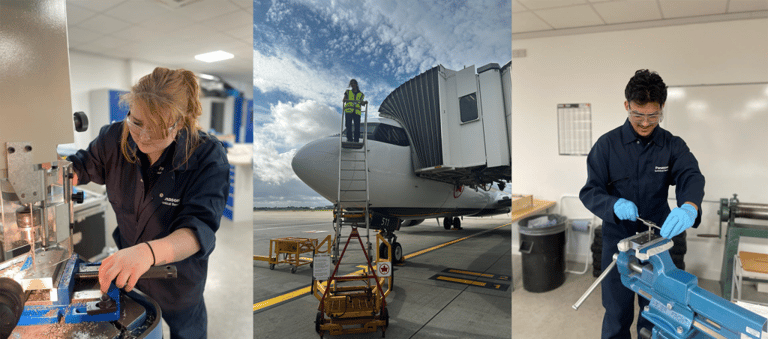As the aviation industry moves toward a future filled with advanced technology and expanding global connections, a silent challenge looms on the horizon: a critical labor shortage of skilled mechanics and engineers. This shortage presents a challenge that could disrupt the entire sector.
In response, Panasonic Avionics is taking proactive steps to secure the future of its workforce, with a new apprenticeship program. Here, amid a blend of classroom learning and hands-on experience, Panasonic is nurturing a new generation of talent.
The first cohort of the Panasonic Technical Services apprenticeship program in the UK is due to finish its first year in March 2024, with an eager new group of apprentices following close behind.
“It's a good way to learn," says Meg Bazeley, who joined as part of the first cohort. “Over the first year, you get the theory side of things and you get the hands-on work."
Gender diversity in maintenance, repair, and operations
Within aviation, women make up less than 20% of the workforce. There are even fewer choosing maintenance, repair, and operations (MRO); there, women make up just 2.6% of workers.
Panasonic understands that its business practices should be rooted in diversity, equity, and inclusion, which is why the apprenticeship invites applicants from all genders, ethnicities, and backgrounds. To build an inclusive environment, apprentices get dedicated support in and outside of their training, with regular check-ins. These help prevent attrition, as well as help build culture and camaraderie among their cohort and the wider program.
“We have these meetings called 'learner progress reviews,'" explains Bazeley, “where we get one-to-one support to discuss exam results, well-being, or concerns. You know there's always someone on hand if you have questions or need anything."
That's also been the experience of Maddie Fletcher, who began her apprenticeship this year as part of cohort two. “I know for a fact if I need support, I can just call," she says. “It's still early days so I haven't really needed that yet, but I know that I could rely on them if I did."

Hands-on learning
The apprenticeship starts with learning concepts and theory, but students are able to get stuck into hands-on work early on. “I'm quite excited to get in the workshop," says Fletcher, who started training in September this year. “Everyone I've spoken to who has done it has said that I'm going to love it."
In the first year, alongside the classroom training and workshops, apprentices take part in work experience at Panasonic Heathrow Line Maintenance to get further hands-on training. This gives them a taste of what's to come in the second and third years of the program, when students get embedded into a fully operational aircraft maintenance facility under the guidance of a mentor.
“I'm looking forward to the placements," says Bazeley. “I'm going back to Heathrow around Christmas time to shadow the engineers on live aircraft." This will give her the chance to experience real-life maintenance tasks and repairs as they come up.
For Fletcher, it's the variety of the apprenticeship so far that has both surprised and interested her. “It was surprising in my cohort the mix of people doing fixed wing and helicopters," she says. “The work is a mix of stuff — we've done all sorts from maths and physics to legislation and aerodynamics."
During the two-year placement, the students will fill out a log book that will form part of the assessment to receive their dual CAA and EASA aircraft maintenance engineer Category A license, allowing them to carry out minor line maintenance work and simple defect rectification. There's also the option to continue training toward a Category B license, which opens up further opportunities and allows engineers to work on even more complex aircraft systems.
Fulfilling industry needs
A recent Wyman report into the top disruptors in the MRO industry found that 65% of European airline executives who responded saw a lack of technical staff as a challenge due to grow over the next five years. This fits with earlier predictions from Wyman, which predicted the shortage of aviation mechanics would threaten the global airline fleet, projecting that demand for these roles would start outpacing supply in 2022 and peak in 2027.
In order to overcome these future challenges, Panasonic is investing in its workforce now. "By training the next generation of maintenance technicians, we can continue to provide the best in-flight entertainment and connectivity service possible for our airline customers and their passengers," says Terry Dudley, Senior Regional Operations Manager at Panasonic.
The apprenticeship not only provides an entry point for new talent but it also improves equality in the industry. With a more diverse workforce, it's easier to attract talent from previously under-represented groups within the industry, such as women. This opens up the potential pool of candidates to include those who may not have previously seen themselves working in aircraft maintenance.
Opportunities for the future
With the predicted shortage of maintenance engineers already affecting recruitment in the avionics industry, now is a great time to consider an apprenticeship. Panasonic is dedicated to building a sustainable, diverse workforce, and the three-year apprenticeship is designed to take students through everything they need to know about aircraft maintenance alongside hands-on learning at both Heathrow and Luton airports.
See yourself working in aircraft maintenance? Panasonic's apprenticeship program may be the right fit for you. Applications for the next cohort are open until January 22, 2024. Keep your eye out for future cohorts' application dates, too. Find out more here.



